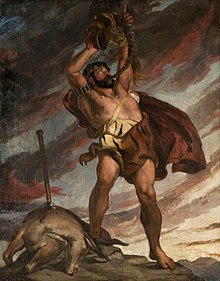
Nimrod by David Scott, 1832
Nimrod (/ˈnɪmrɒd/;[1] Hebrew: נִמְרוֹדֿ, Modern: Nimrôd, Tiberian: Nimrôḏ; Aramaic: ܢܡܪܘܕ; Arabic: اَلنّمْرُود, romanized: an-Namrūd; Persian: نمرود, romanized: Namrud; Turkish: Nemrud), a biblical figure described as a king in the land of Shinar (Mesopotamia), was, according to the Book of Genesis and Books of Chronicles, the son of Cush. The Bible states that he was "a mighty hunter before the Lord [and] ... began to be mighty in the earth".[2] Extra-biblical traditions associating him with the Tower of Babel led to his reputation as a king who was rebellious against God.
Attempts to match Nimrod with historically attested figures have failed. Nimrod may not represent any one personage known to history and various authors have identified him with several real and fictional figures of Mesopotamian antiquity, including the Mesopotamian god Ninurta or a conflation of two Akkadian kings Sargon, his grandson Naram-Sin (2254–2218 BCE), and Tukulti-Ninurta I (1243–1207 BCE).
Biblical account
Traditions and legends
Historical interpretations

Inscription of Naram Sin found at the city of Marad
Historians, Orientalists, Assyriologists and mythographers have long tried to find links between Nimrod and real historically attested figures in Mesopotamia.
Since the city of Akkad was destroyed and lost with the destruction of its Empire in the period 2200–2154 BC (long chronology), the stories mentioning Nimrod seem to recall the late Early Bronze Age. The association with Erech (Sumero-Akkadian Uruk), a city that lost its prime importance around 2,000 BC as a result of struggles between Isin, Ur, Larsa and Elam, also attests the early provenance of the stories of Nimrod.[7] Several Mesopotamian ruins were given Nimrod's name by 8th-century AD Arabs, including the ruins of the Assyrian city of Kalhu (the biblical Calah), built by Shalmaneser I (1274–1244 BC)[3] A number of attempts to connect him with historical figures have been made.
The Christian Bishop Eusebius of Caesarea as early as the early 4th century, noting that the Babylonian historian Berossus in the 3rd century BC had stated that the first king after the flood was Euechoios of Chaldea, identified him with Nimrod. George Syncellus (c. 800) also had access to Berossus, and he too identified Euechoios with the biblical Nimrod. More recently, Sumerologists have suggested additionally connecting both this Euechoios, and the king of Babylon and grandfather of Gilgamos who appears in the oldest copies of Aelian (c. 200 AD) as Euechoros, with the name of the founder of Uruk known from cuneiform sources as Enmerkar.[36]
In 1920, J. D. Prince also suggested a possible link between the Lord (Ni) of Marad and Nimrod. He mentioned how Dr. Kraeling was now inclined to connect Nimrod historically with Lugal-Banda, a mythological king mentioned in Poebel, Historical Texts, 1914, whose seat was at the city Marad.[37]
According to Ronald Hendel the name Nimrod is probably a polemical distortion of the god Ninurta, a prominent god in Mesopotamian religion who had cult centers in a number of Assyrian cities such as Kalhu, and also in Babylon, and was a patron god of a number of Assyrian kings.[38] Nimrod's imperial ventures described in Genesis may be based on the conquests of the Assyrian king Tukulti-Ninurta I (Dalley et al., 1998, p. 67). Julian Jaynes also indicates Tukulti-Ninurta I (a powerful king of the Middle Assyrian Empire) as the origin for Nimrod.[39] Alexander Hislop, in his tract The Two Babylons, decided that Nimrod was to be identified with Ninus (also unattested in Mesopotamian king lists), who according to Greek legend was a Mesopotamian king and husband of Semiramis, with a whole host of deities throughout the Mediterranean world, and with the Persian Zoroaster. The identification with Ninus follows that of the Clementine Recognitions; the one with Zoroaster, that of the Clementine Homilies, both works part of Clementine literature.[40] There was a historical Assyrian queen Shammuramat in the 9th century, the wife of Shamshi-Adad V, whom some speculations have identified with Semiramis, while others make her a later namesake of a much earlier Semiramis.
In David Rohl's theory, Enmerkar, the Sumerian founder of Uruk, was the original inspiration for Nimrod, because the story of Enmerkar and the Lord of Aratta[41] bears a few similarities to the legend of Nimrod and the Tower of Babel, and because the -KAR in Enmerkar means "hunter". Additionally, Enmerkar is said to have had ziggurats built in both Uruk and Eridu, which Rohl postulates was the site of the original Babel.
George Rawlinson believed Nimrod was Belus (like Nimrod and Ninus a king not attested in Mesopotamian annals, but claimed by the later Greeks to have been a king of Assyria) based on the fact Babylonian and Assyrian inscriptions bear the names Bel-Nibru.[42] The word Nibru in the Akkadian language of Assyria and Babylonia comes from a root meaning to 'pursue' or to make 'one flee', and as Rawlinson pointed out not only does this closely resemble Nimrod's name but it also perfectly fits the description of Nimrod in Genesis 10: 9 as a great hunter. The Belus-Nimrod equation or link is also found in many old works such as Moses of Chorene and the Book of the Bee.[43] Nibru, in the Sumerian language, was the original name of the city of Nippur.
Joseph Poplicha wrote in 1929 about the identification of Nimrod in the first dynasty or Uruk[44]
Yigal Levin (2002) suggests that Nimrod was a recollection of Sargon of Akkad and of his grandson Naram-Sin, with the name "Nimrod" derived from the latter. He argues that:
Comments
Post a Comment